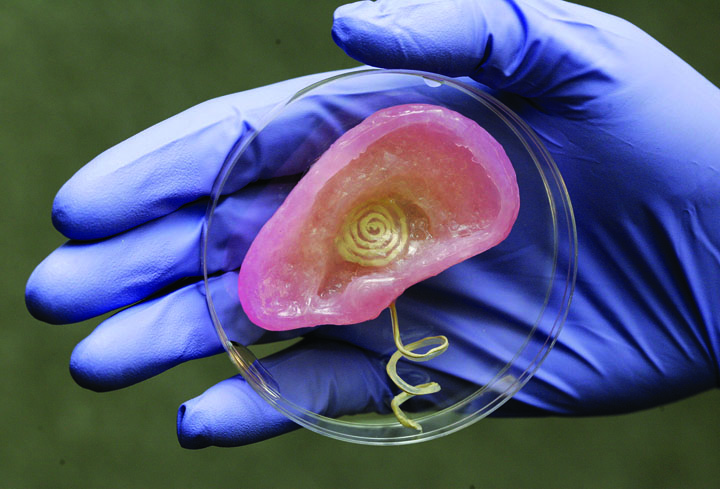Another scientific breakthrough has yet to bridge the divide between science and ethics. Koli Mitra walks the tightrope.
When Star Trek’s Doctor Crusher needed a new body part for a patient – perhaps someone who lost a limb while repairing the star ship’s “warp engine” – she had some fantastic 24th Century technology at her disposal. She could just tweak a “food replicator” by supplying it the molecular and design specifications for a toe, a liver, or an ear.
Now it seems we’ve arrived at the 24th Century well ahead of schedule. Today’s additive manufacturing devices (‘3D printers’) are being used to “print out” everything from the delightful, (violins and chocolate) to the truly disturbing (guns).
How it works is, you send instructions from a computer to a machine, like an inkjet printer, except, instead of making 2-dimensional images with ink sprayed in designated patterns, it takes some substance (polymer sheets, powders, or pulps) and layers it in designated patterns to form a precisely shaped 3-dimensional object.
This year, biomedical researchers at Cornell University made a prototype human ear by “printing” a collagenhydrogel mould from 3D image files of a natural ear and seeded it with a cartilage cell culture, which then grew into fully-formed ear cartilage. Right now, only the structure is human; the cells came from animals. But as biochemical processes become easier to automate, like the manufacturing already is, organ printing could become routine. Just as monochromatic document printing soon gave way to multicoloured printing, the earliest 3D printers, which printed only single-substance structures, are giving way to machines that can use multiple materials in numerous combinations, making things that are not only morphologically complex, like musical instruments, but also have to be chemically precise, like food… or both, like body parts.
This has extraordinary implications for regenerative and reconstructive medicine. For centuries, surgeons have tried to replace lost or damaged physical features, by attaching prosthetics, transplanting organs donated by others, and grafting pieces of tissue taken from other areas of patients’ own bodies. But the most painstaking reconstructive surgery can still only create (relatively) crude facsimiles of a limb, digit, or organ that nature seems to produce so effortlessly. If you’re missing an ear, a surgeon can fashion a new one from cartilage found elsewhere in your body, typically the ribs. But ear cartilage has unique properties, giving it a perfect balance of strength and flexibility, ideal for an ear’s functions, which rib cartilage just can’t match.
Some organs – hearts, lungs, pancreases – are too complex to reconstruct from a body’s other tissues. So, transplantation is the only option. But naturally occurring organs aren’t exactly lying around as spare parts. Someone has to die or at least undergo an amputation to give an organ. Moreover, there are serious concerns about organ trafficking and coercion of impoverished and marginalized people. This means organs obtained safely and ethically often come from people who have died from illness or old age and not always in the best condition. Most usable organs tend to be from accident victims – not something we’d like to see increasing. The potential for using animal organs – or xenotransplantation – has been studied, but, so far without success; and it raises profound ethical issues of its own. Also, transplantation (even within our species) comes with a risk that the patient’s immune system – evolved to fight off invasive foreign biological matter – will reject the transplant. So… the prospect of growing new organs from patients’ own cells is getting much interest these days, making “regenerative medicine” the hottest new research field.
Scientists have cultured human cells in laboratories for years, but now, they’re increasingly able to custom-design cells to fit specialised requirements. Human embryonic stem cells can be developed into any cell the body needs. This year, for the first time, patient-specific embryonic stem cells were successfully cloned from adult human cells (which can be implanted into the same adult human without rejection risk, since they’re not genetically “foreign”). Another patient-specific process, now favoured by most researchers, is “induced pluripotent stem cells” (iPS) derived from adult somatic cells by reprogramming them to act like embryonic stem cells. The iPS method eliminates ethically murky issues associated with embryonic stem cells (like cloning and embryo-destruction).
Cells, though, are just building blocks. Once you’ve created some in a petri dish, how do you configure them to form a functioning organ? Among other things, you’ll need a mould – a scaffold – on which the cells could grow to give the organ the right form. In 2011, scientists at the University of Minnesota, led by Dr. Doris Taylor, found a way to chemically dissolve all of the cellular material on a heart without damaging its underlying protein ‘skeleton’. It left behind what Taylor calls a “ghost heart”, an exact matrix of the human heart – down to the finest branches of the most intricate web of capillaries – that can serve as the scaffold for growing a new heart from a patient’s own cells.
Dr. Taylor may not have to strip a real heart down to its skeleton every time, however. She can just keep a complete profile of 3D images of the organ in a computer file and just “print” the scaffolding using appropriate materials. Nobody has successfully printed a heart matrix yet, but the Cornell team did make an ear, and that’s certainly a start.
But is it all good news? 3D printers are already being used to make handguns. What sinister purposes might be served in future when people can manufacture biology at home? Researchers are understandably focused on the therapeutic purposes for which they are developing the technology. But, our moral development as a species hasn’t always kept pace with our dazzling capacity for technical innovation. For now, I guess we’ll just have to play it by ear.














